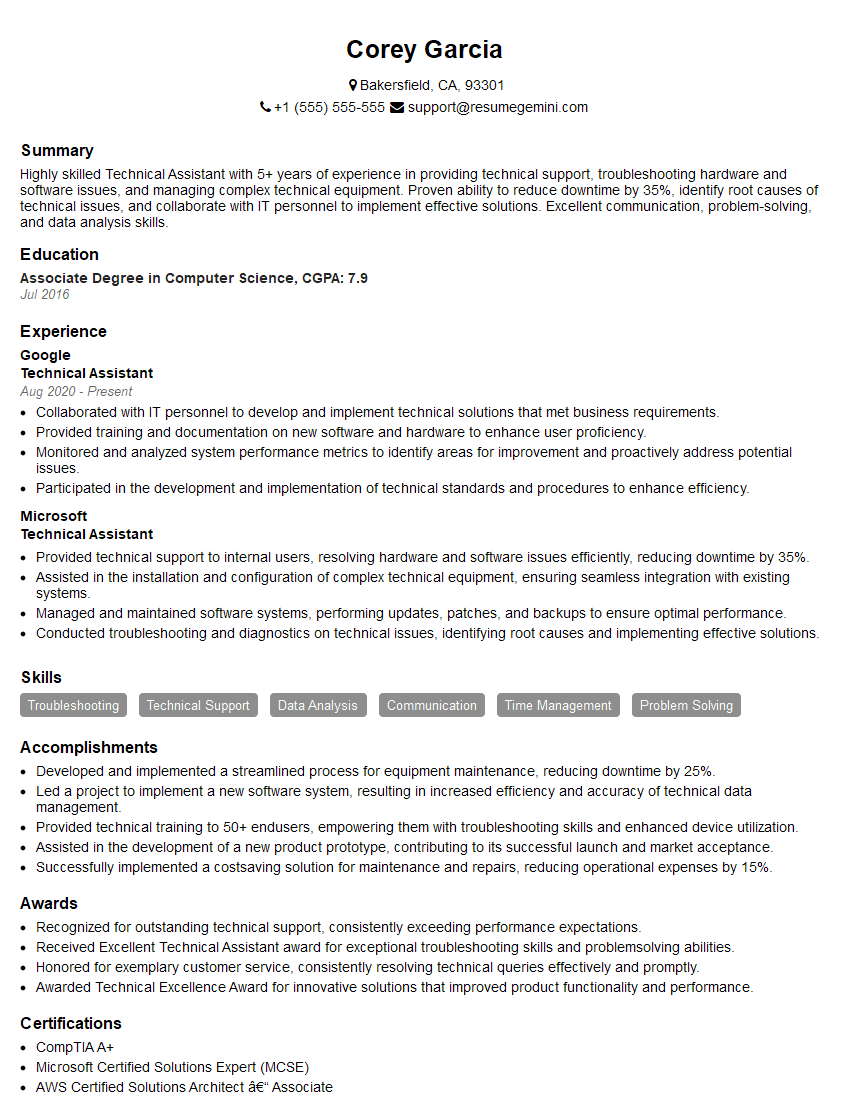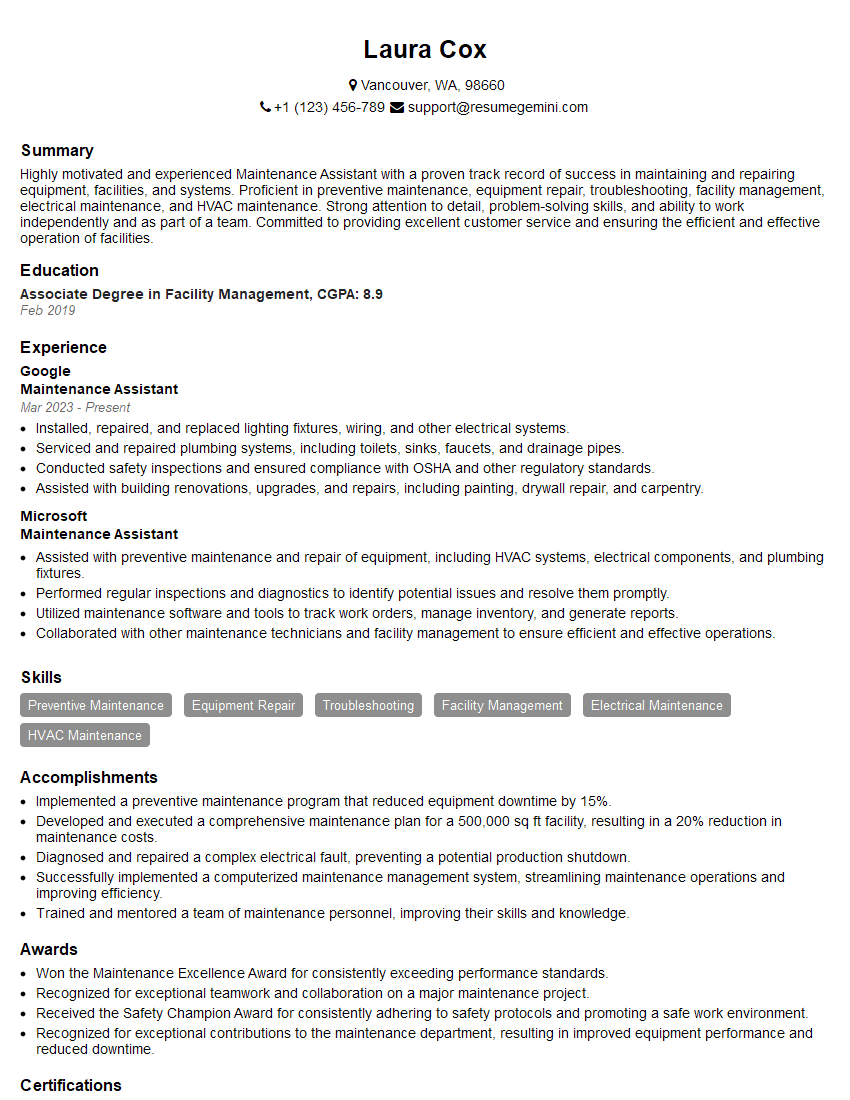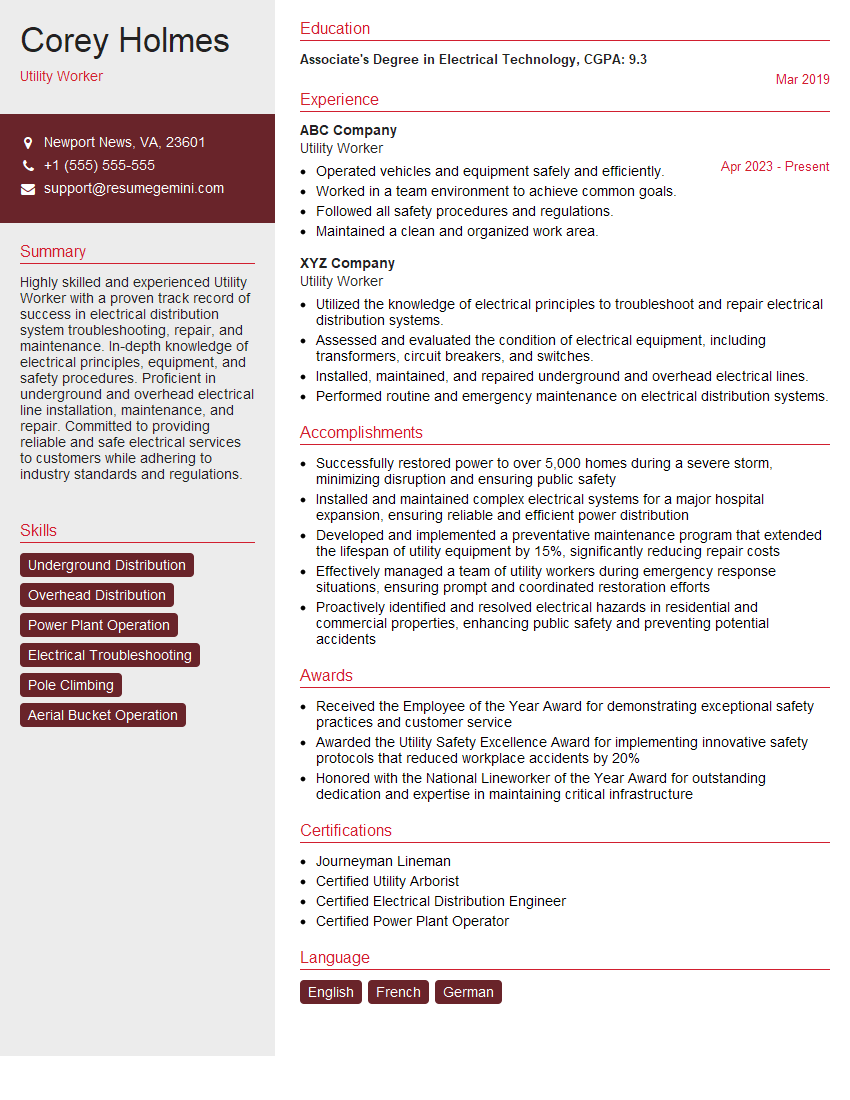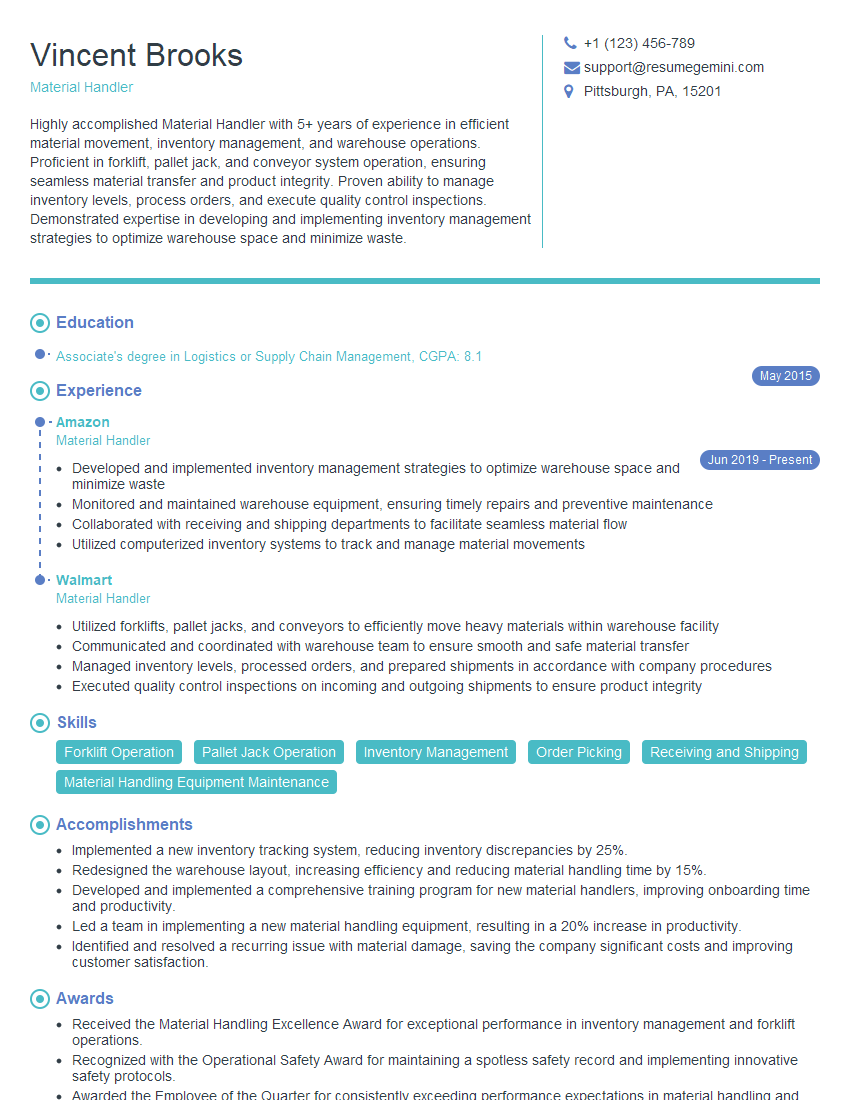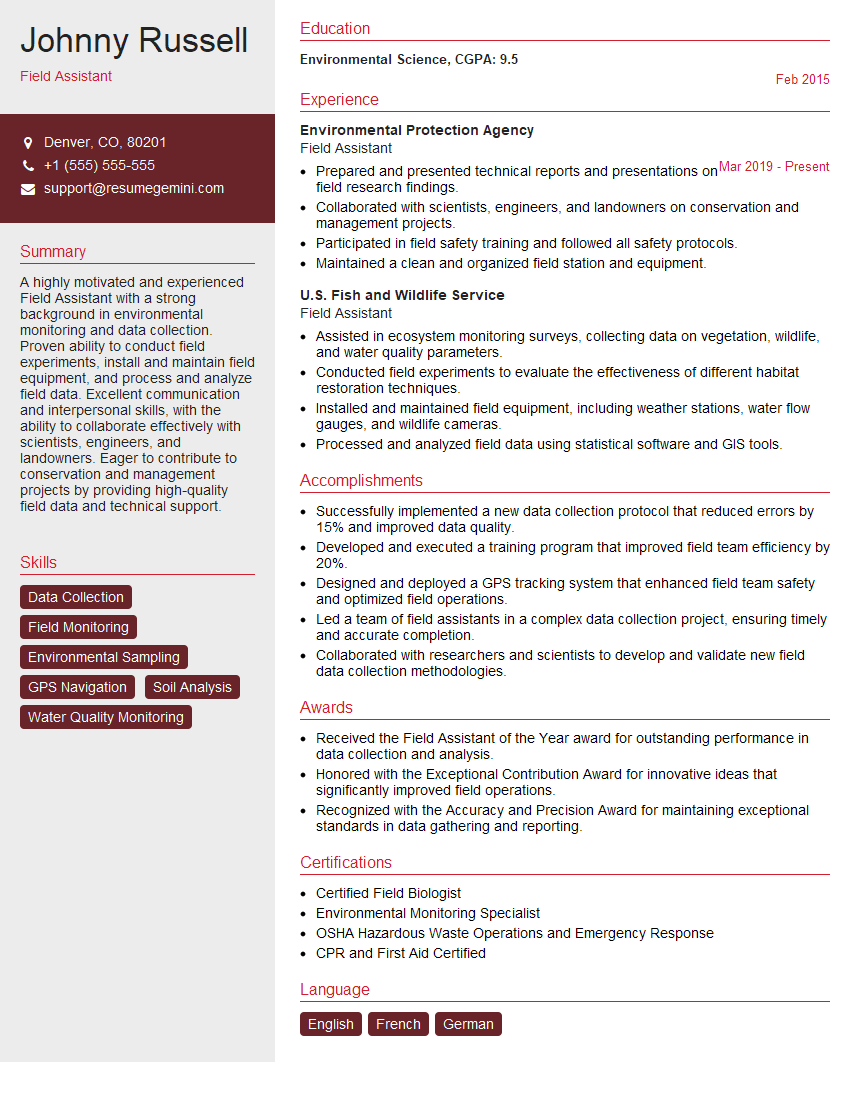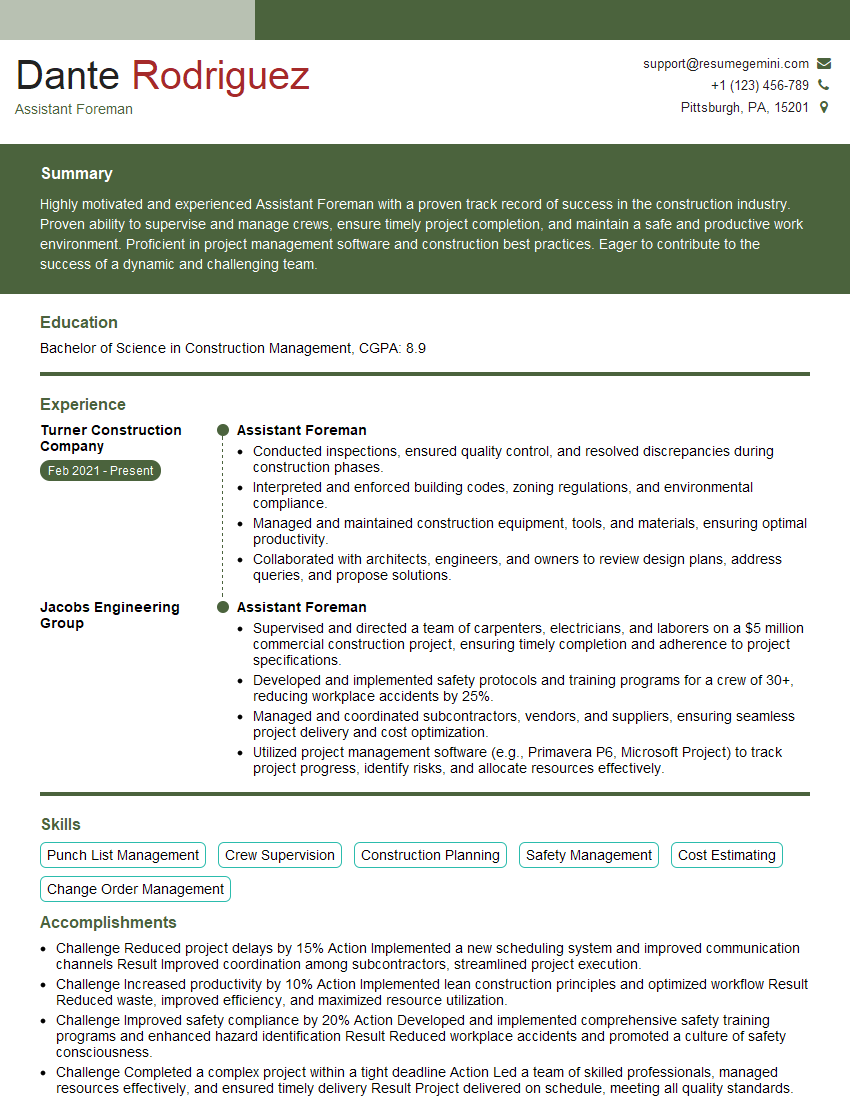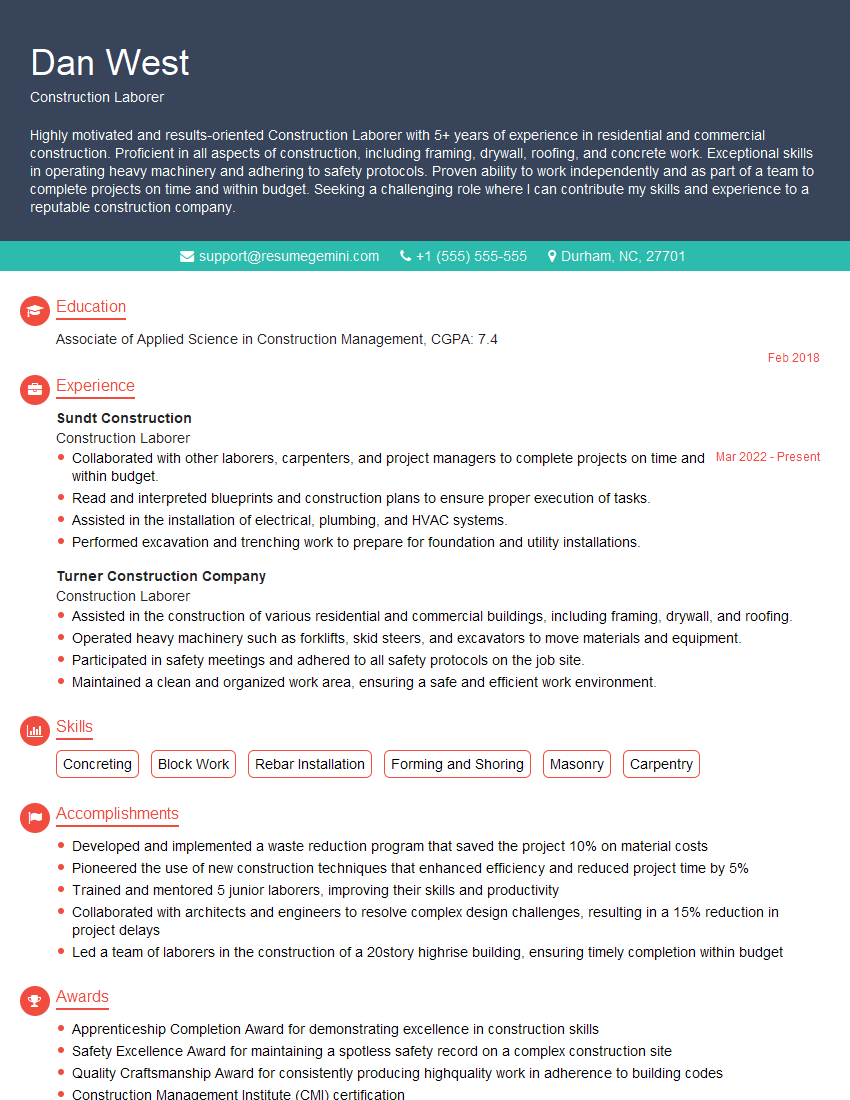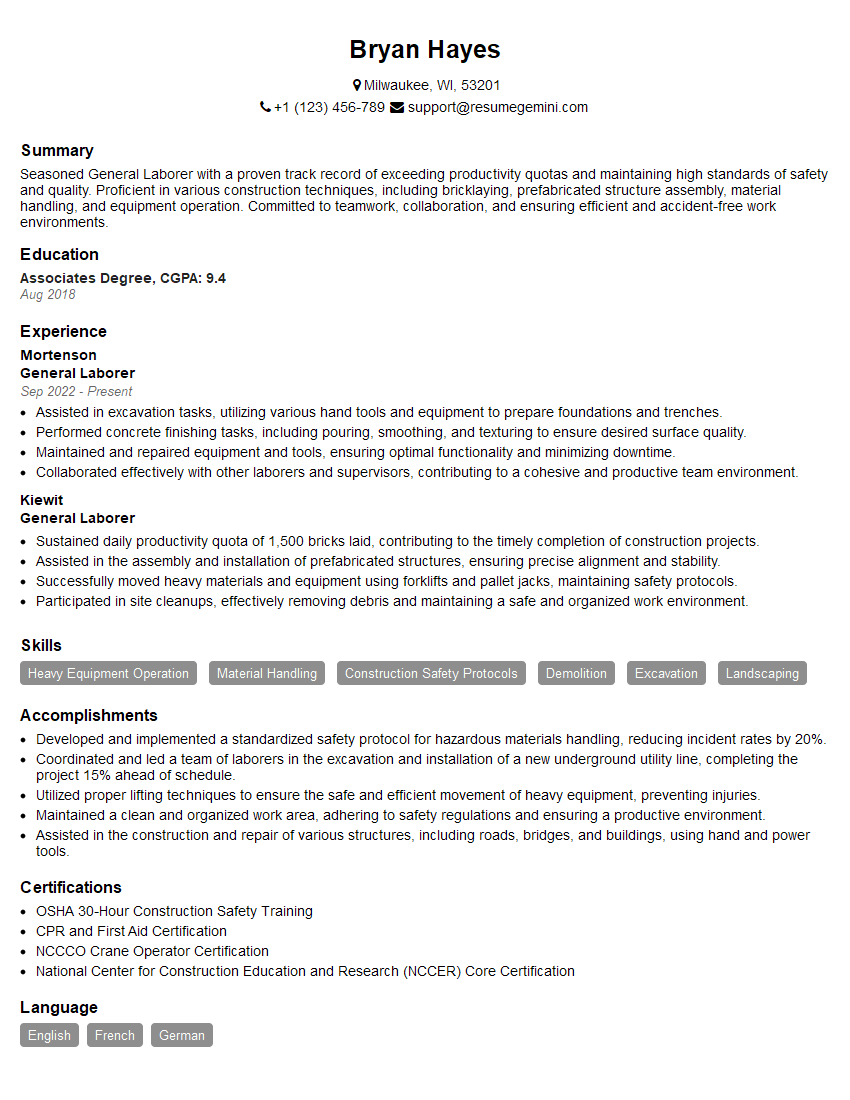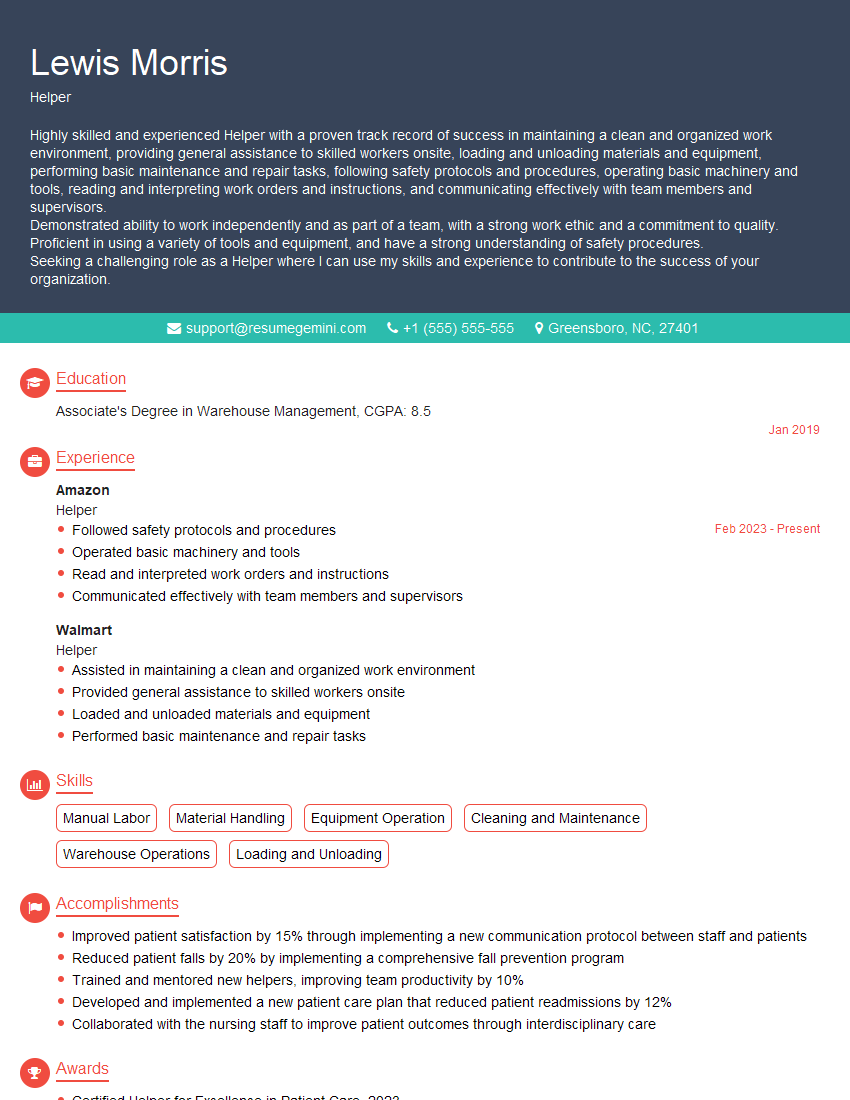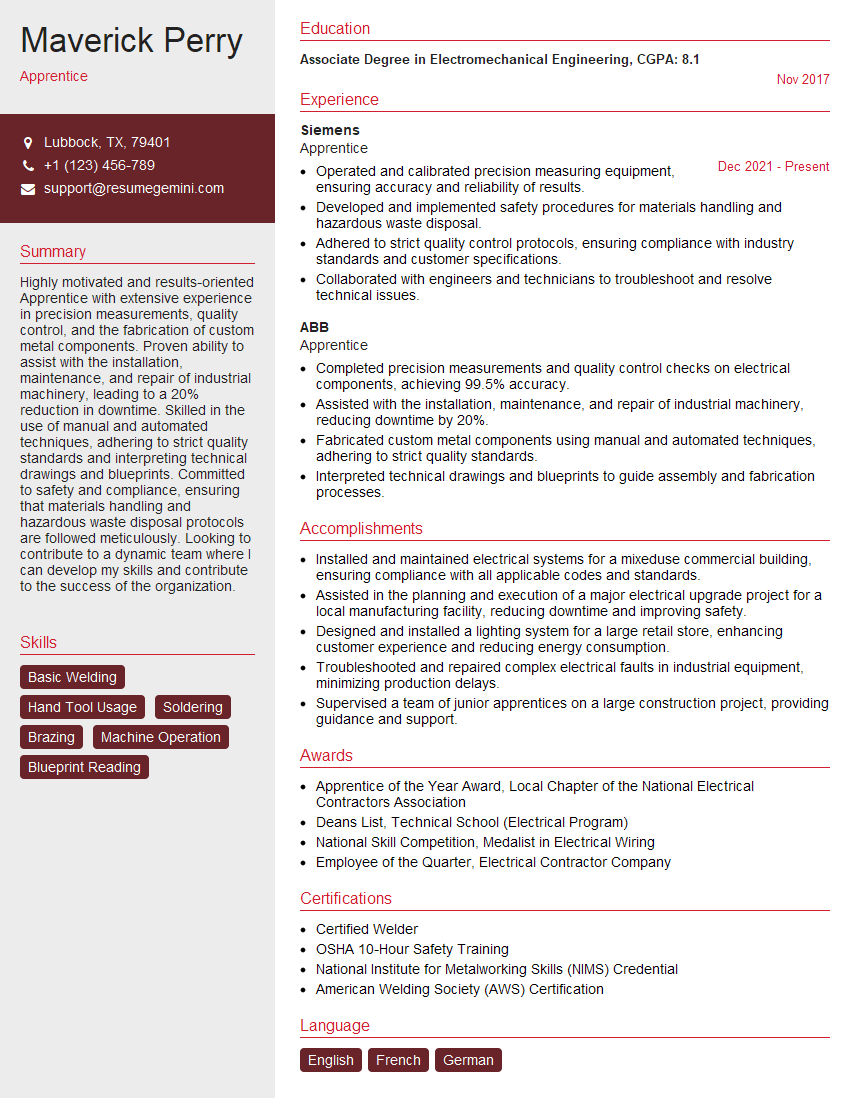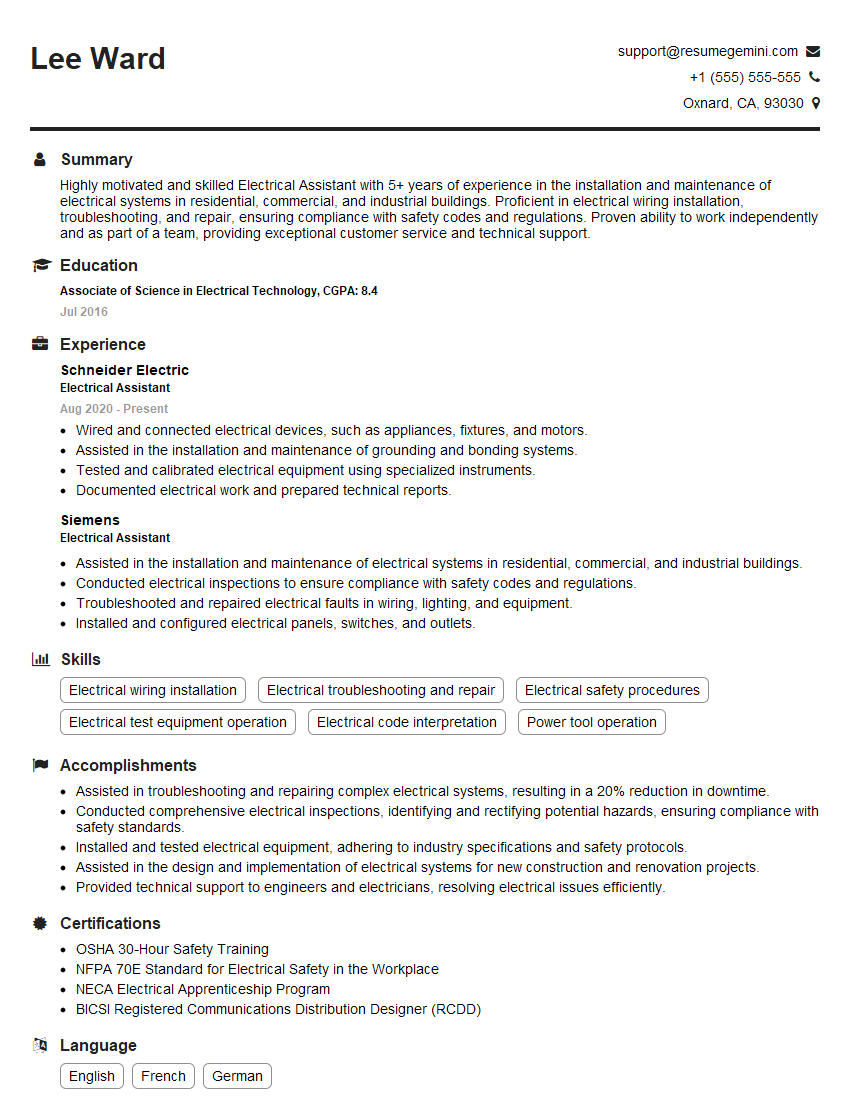Every successful interview starts with knowing what to expect. In this blog, we’ll take you through the top Provided support for other trades interview questions, breaking them down with expert tips to help you deliver impactful answers. Step into your next interview fully prepared and ready to succeed.
Questions Asked in Provided support for other trades Interview
Q 1. Describe your experience assisting skilled tradespeople.
My experience assisting skilled tradespeople spans over five years, encompassing various construction projects ranging from residential renovations to large-scale commercial builds. I’ve worked closely with electricians, plumbers, carpenters, and drywall installers, providing support in many ways. This includes preparing work areas, fetching and organizing tools and materials, cleaning up debris, and ensuring a safe and efficient work environment. For instance, on a recent project involving electrical conduit installation, I prepped the walls by removing obstructions and ensuring proper access for the electrician, significantly speeding up their work. In another instance, I assisted a carpentry team by carefully stacking and labeling lumber according to size and species, saving them valuable time in material selection.
Q 2. What safety protocols are you familiar with in a construction environment?
Safety is paramount in any construction environment. I’m thoroughly familiar with and adhere to OSHA (Occupational Safety and Health Administration) standards. This includes proper use of Personal Protective Equipment (PPE) like hard hats, safety glasses, gloves, and steel-toe boots. I understand and follow lockout/tagout procedures for equipment maintenance, recognizing the importance of preventing accidental starts. Furthermore, I’m trained in hazard identification and reporting, and I’m adept at recognizing potential fall hazards, ensuring proper scaffolding is used and that workers are using appropriate fall protection. I’m also aware of and proficient in handling hazardous materials following all relevant safety guidelines.
Q 3. How do you handle physically demanding tasks?
Construction work can be physically demanding, but I’ve developed techniques to handle strenuous tasks efficiently and safely. I prioritize proper lifting techniques to avoid injury, using my legs and core to lift heavy objects and keeping my back straight. I regularly take short breaks to rest and hydrate, especially during periods of intense physical activity. I also actively maintain my physical fitness outside of work, ensuring I have the stamina and strength to manage the job’s physical requirements. Understanding my physical limits is key; if a task is beyond my capabilities, I immediately communicate this to the appropriate skilled tradesperson and seek assistance.
Q 4. Explain your experience with material handling and organization.
Material handling and organization are critical aspects of my role. I’m experienced in safely handling a wide range of materials, from lumber and drywall to electrical conduit and plumbing pipes. My approach is methodical: I always check material deliveries against orders to ensure accuracy, and I carefully sort and store materials according to type and project needs. I utilize labeling systems to clearly identify materials and their location, minimizing the time spent searching. Think of it like a well-organized inventory system – keeping everything in its place reduces delays and prevents accidental damage or misplacement. For example, I’ve implemented a color-coded system for different types of fasteners, making it easy for tradespeople to locate the correct ones quickly.
Q 5. Describe a time you had to troubleshoot a problem for a skilled tradesperson.
During the installation of a complex HVAC system, the electrician encountered difficulty connecting a specific wire. The wiring diagram was ambiguous, and standard troubleshooting methods weren’t immediately successful. I assisted by carefully reviewing the blueprints and schematics alongside the electrician, cross-referencing the wiring diagram with the actual layout of the system. By meticulously tracing the wire paths and identifying points of discrepancy between the diagram and reality, we discovered a mislabeling in the wiring diagram. After correcting the diagram, the electrician was able to complete the connection efficiently. This highlighted the value of thorough documentation and close collaboration in overcoming technical challenges.
Q 6. How familiar are you with different hand tools and power tools?
I’m very familiar with a wide range of hand and power tools commonly used in construction. This includes basic hand tools like hammers, screwdrivers, levels, and measuring tapes, along with power tools such as drills, saws (circular, reciprocating, and miter), and nail guns. I know how to use each tool safely and effectively. My understanding extends beyond simple operation; I know how to maintain, clean, and troubleshoot basic issues with many of these tools, ensuring that they are always ready to use. For example, I can change drill bits, sharpen saw blades, and clear blockages in nail guns, contributing to a smooth workflow.
Q 7. How do you ensure your work supports the efficiency of other trades?
My primary goal is to enhance the efficiency of other trades. I achieve this by anticipating their needs and removing obstacles that could impede their progress. This includes ensuring they have the necessary tools and materials readily available, maintaining a clean and organized workspace, and proactively identifying and addressing potential issues before they become major problems. For example, by pre-assembling components or preparing areas ahead of time, I’m able to reduce wait times, and subsequently contribute to staying on schedule and reducing project costs. Constant communication and collaboration with the tradespeople ensure alignment and a shared understanding of project objectives – this is crucial for effective teamwork and project success.
Q 8. Describe your experience with blueprint reading or understanding construction drawings.
Blueprint reading is fundamental to my role. I’m proficient in interpreting architectural, structural, mechanical, and electrical drawings. My experience encompasses understanding symbols, scales, and dimensions to anticipate the needs of various trades. For instance, I can identify the location of plumbing fixtures from the plumbing drawings and relay this information accurately to the plumbers, ensuring efficient coordination. I also understand section views, elevations, and details to accurately visualize the project’s three-dimensional aspects. This allows me to anticipate potential conflicts between trades early in the process and avoid costly rework later.
For example, by examining the structural drawings and the electrical drawings simultaneously, I recently identified a potential conflict where a beam placement would interfere with the planned electrical conduit routing. By flagging this early to the structural engineer and electrician, we were able to revise the plans and avoid significant delays and changes during construction.
Q 9. How do you maintain a clean and organized workspace?
Maintaining a clean and organized workspace isn’t just about tidiness; it’s about safety and efficiency. My approach involves a systematic process. First, I dedicate time at the beginning and end of each day to organizing materials and tools. This includes ensuring all tools are stored properly, materials are neatly stacked and labeled, and the area is free of debris. Throughout the day, I practice ‘5S’ – Sort, Set in Order, Shine, Standardize, Sustain – as a guiding principle. This helps keep things running smoothly, prevents accidents caused by clutter, and reduces time spent searching for items. For example, I color-code toolboxes for different trades, making it immediately clear where certain tools are located. This has drastically improved the workflow and helped prevent delays caused by searching for the wrong tools.
Q 10. How do you communicate effectively with skilled tradespeople and supervisors?
Effective communication is paramount in this field. I prioritize clear, concise, and respectful communication with all tradespeople and supervisors. I use a combination of verbal and written communication methods depending on the situation and audience. With skilled tradespeople, I focus on providing precise instructions and actively listening to their feedback, ensuring everyone is on the same page. With supervisors, I provide regular updates on progress, potential challenges, and solutions. I also utilize visual aids like sketches or photos to clarify complex issues. Active listening and clarifying questions are key to avoiding misunderstandings. For example, if an electrician tells me a particular task will delay the work, I immediately confirm my understanding of the issue and potential solutions, ensuring transparency and minimizing disruptions.
Q 11. What are your strengths in working as part of a team?
My strengths as a team player are rooted in collaboration, adaptability, and problem-solving. I believe in actively contributing to a positive team dynamic, supporting my colleagues and sharing my knowledge. I am also adaptable, easily adjusting my approach to accommodate changing circumstances and team needs. My problem-solving skills enable me to effectively identify and resolve conflicts or challenges that arise, fostering a productive team environment. For instance, on a recent project, a shortage of materials caused a potential delay. By proactively contacting suppliers and coordinating with other trades, we found an alternative solution, preventing significant project disruption. This required open communication, a collaborative approach, and a willingness to adjust the schedule, showcasing my team-oriented approach.
Q 12. How do you prioritize tasks when multiple trades require your assistance?
Prioritizing tasks when multiple trades need assistance requires a structured approach. I typically use a combination of urgency, dependency, and impact analysis. I first assess which tasks are time-sensitive (urgent), which tasks depend on the completion of others (dependency), and which tasks will have the most significant impact on the overall project schedule (impact). This allows me to prioritize tasks that must be completed first, thereby minimizing delays and ensuring smooth workflow. For example, if the electricians need access to a specific area before the drywallers can complete their work, I will prioritize assisting the electricians to prevent a cascading delay that could impact other trades.
Q 13. Describe your experience with equipment operation (e.g., forklifts, hand trucks).
I am certified to operate forklifts and have extensive experience using hand trucks. My experience encompasses safe operation techniques, regular maintenance checks, and adherence to all safety regulations. I understand the importance of load capacity, stability, and maneuvering in confined spaces. I am proficient in using the equipment efficiently and safely, ensuring the smooth and timely movement of materials on the site. For instance, I regularly use forklifts to move large quantities of lumber, ensuring safe and efficient transportation. I perform pre-operation checks, adhering strictly to safety regulations before each operation. This ensures a safe work environment and minimizes the risk of accidents.
Q 14. Have you worked with different types of building materials? List some examples.
My experience encompasses working with a wide array of building materials, including lumber (various grades and species), drywall, concrete, steel, various types of insulation (fiberglass, spray foam), roofing materials (shingles, tiles, membrane), and various finishes like paint, tile, and flooring materials (carpet, vinyl, hardwood). Understanding the properties and handling requirements of these materials is crucial for ensuring efficient and safe work practices. For instance, knowing the proper techniques for handling and storing lumber prevents warping or damage. Similarly, understanding the different types of concrete mixes helps to select the appropriate one for specific applications, impacting the project’s overall strength and longevity.
Q 15. How do you ensure the safety of yourself and others while providing support?
Safety is paramount in my work. It’s not just about following rules; it’s about proactively anticipating risks. My approach is threefold: Preparation, Observation, and Communication.
Preparation: Before any job, I thoroughly review the site plans, safety protocols, and any relevant permits. I ensure I have the correct personal protective equipment (PPE), such as safety glasses, gloves, steel-toed boots, and high-visibility clothing, appropriate for the task and environment. For example, when assisting electricians, I always wear insulated gloves and ensure the area is properly de-energized before working near live wires.
Observation: I constantly scan my surroundings for potential hazards, from exposed wiring and trip hazards to unsafe work practices by other tradespeople. I don’t hesitate to point out potential risks. For instance, if I see a plumber leaving tools scattered on the floor, I’ll politely remind them of the trip hazard and suggest a better storage solution.
Communication: Clear and consistent communication is essential. I regularly communicate with the lead tradesperson and other team members to update them on my progress, any issues I encounter, and any safety concerns. This ensures everyone is on the same page and working safely.
Career Expert Tips:
- Ace those interviews! Prepare effectively by reviewing the Top 50 Most Common Interview Questions on ResumeGemini.
- Navigate your job search with confidence! Explore a wide range of Career Tips on ResumeGemini. Learn about common challenges and recommendations to overcome them.
- Craft the perfect resume! Master the Art of Resume Writing with ResumeGemini’s guide. Showcase your unique qualifications and achievements effectively.
- Don’t miss out on holiday savings! Build your dream resume with ResumeGemini’s ATS optimized templates.
Q 16. Describe your problem-solving skills related to on-site challenges.
Problem-solving on-site requires a systematic approach. I use a three-step process: Identify, Analyze, and Implement.
Identify: The first step is clearly defining the problem. This often involves asking clarifying questions to the lead tradesperson and carefully observing the situation. For example, if an electrician is struggling to run a wire through a tight space, I might need to understand the exact dimensions and material of the wire to help find a solution.
Analyze: Once the problem is identified, I analyze possible solutions. This might involve consulting technical manuals, diagrams, or even brainstorming with the lead tradesperson. For the wire example, I might suggest using a different type of wire, a fish tape, or perhaps creating a new access point.
Implement: After selecting the best solution, I implement it carefully and efficiently. This includes documenting the process and any modifications made. If a new access point needs to be created, I’d ensure that it is done safely and to the required specifications.
I value creative solutions and am not afraid to think outside the box. Once, a plumbing issue was causing significant delays. The main pipe was inaccessible. By collaborating with the plumber, we found a less conventional way to access it which required less demolition and kept the project on schedule.
Q 17. How do you adapt to changing work conditions or priorities?
Adaptability is key in this field. Work conditions and priorities change constantly. My approach is to stay flexible, prioritize tasks effectively, and maintain open communication.
Flexibility: I’m comfortable switching between tasks as needed. If a priority shifts, I adjust my schedule and focus my efforts accordingly. I’ve often found that I can help a stalled task by offering support, freeing up the lead tradesperson to address the new priority.
Prioritization: I use time management techniques to prioritize tasks based on urgency and importance. This ensures that critical tasks get completed first, even if plans change unexpectedly.
Communication: Maintaining open communication is vital. I keep the lead tradesperson informed of any changes to my schedule and any challenges I encounter while adapting to new priorities.
Q 18. What is your understanding of different trade specialties (e.g., electrical, plumbing)?
I have a working knowledge of various trades, although I’m not a specialist in any of them. My understanding encompasses the basics of:
Electrical: I understand basic electrical safety procedures, wiring types, and common electrical tools. I can assist electricians by preparing areas, running conduit, and organizing materials.
Plumbing: I am familiar with different pipe types, fittings, and basic plumbing tools. I can assist plumbers by preparing areas, cleaning up debris, and carrying materials.
HVAC: I have a basic understanding of HVAC systems and the importance of proper ventilation and airflow. I can help with tasks such as moving materials and maintaining a clean workspace.
Carpentry: I am familiar with basic carpentry techniques and tools. I can assist carpenters by handling materials, measuring and cutting lumber (with supervision), and preparing surfaces.
This foundational knowledge allows me to provide effective support across multiple trades, while recognizing the limitations of my expertise and always deferring to the lead tradesperson’s judgment.
Q 19. How do you manage your time effectively to meet deadlines?
Effective time management is critical. I use a combination of planning, prioritization, and monitoring to meet deadlines.
Planning: At the start of each day or project, I create a prioritized to-do list, breaking down larger tasks into smaller, manageable steps. I also factor in potential delays and build in buffer time.
Prioritization: I prioritize tasks based on urgency and importance, focusing on high-impact tasks first. I use techniques like the Eisenhower Matrix (urgent/important) to categorize tasks effectively.
Monitoring: I regularly monitor my progress throughout the day, adjusting my schedule as needed. I communicate any potential delays or challenges to the lead tradesperson promptly.
For instance, if I see that one task is taking longer than expected, I might adjust my schedule by delegating some less urgent tasks or seeking help from others to stay on track.
Q 20. Explain your experience with quality control in your support role.
Quality control in my support role involves ensuring that materials are handled correctly, tools are in good working order, and work areas are kept clean and organized. My contribution to quality control is indirect but vital.
Material Handling: I carefully handle all materials to prevent damage or loss. This includes proper storage and organization to ensure they are readily available when needed. This prevents delays and ensures the tradespeople have access to the right materials.
Tool Maintenance: I assist in keeping the tools clean and organized, reporting any damaged or missing tools immediately. This ensures the tradespeople have the tools they need in optimal condition.
Workspace Organization: I maintain a clean and organized work area by removing debris, storing materials properly, and ensuring a safe working environment. A clutter-free space reduces the risk of accidents and improves efficiency.
For example, by keeping the work area clean and organized, I prevent tradespeople from tripping over tools or materials. I also make sure that the proper materials are stored, preventing waste and ensuring the use of correct materials for the job. This directly contributes to the overall quality of the project.
Q 21. How do you identify and report potential hazards on a job site?
Identifying and reporting hazards is a crucial part of my responsibilities. My approach combines proactive observation with immediate reporting.
Proactive Observation: I regularly scan my surroundings, looking for anything that could pose a risk – exposed wiring, unstable scaffolding, spills, improperly stored materials, or unsafe work practices by others.
Immediate Reporting: If I identify a hazard, I report it immediately to the lead tradesperson or the site supervisor. My reports are clear, concise, and include the location of the hazard, its nature, and any potential consequences.
Documentation: I may take photographs or make written notes of the hazard for documentation purposes. This ensures that the hazard is properly addressed and documented.
For instance, if I notice a crack in the scaffolding, I would immediately inform the supervisor and provide a photograph as evidence of the problem. I would then follow up to ensure that the hazard is addressed promptly and that the necessary repairs are made.
Q 22. Describe a time you had to learn a new skill or technique quickly.
One time I had to rapidly acquire a new skill was during a large-scale renovation project. We were installing a complex, high-end sound system in a newly constructed home, a task outside my usual electrical work. The audio-visual installer, who was supposed to handle this aspect, fell ill at the last minute. The deadline was immovable – the clients were moving in within 48 hours.
Instead of panicking, I immediately contacted the AV company’s support line. They walked me through the schematics, explaining the wiring diagrams and signal routing. I learned about impedance matching, signal amplification, and speaker placement. It was intense, requiring late nights and intense focus on their provided manuals and online tutorials.
I systematically tackled each component, starting with the basic wiring, then progressing to the more complex aspects like calibration and speaker configuration. I documented every step, taking photos and notes. Within 48 hours, the system was installed and fully functional, receiving positive feedback from the client. This experience showed me the power of quick learning, resourcefulness, and methodical problem-solving under pressure. It also significantly expanded my skill set beyond traditional electrical work.
Q 23. What are your salary expectations for this role?
My salary expectations are in line with the industry standard for someone with my experience and skill set in supporting other trades. Considering my proficiency in troubleshooting, my ability to anticipate and address potential problems before they impact other trades, and my proven track record of efficiency and problem-solving, I’m targeting a salary range of [Insert Salary Range] annually. I’m confident that my contributions will significantly benefit your company and am open to discussing this further based on a complete understanding of the role’s responsibilities and the company’s compensation structure.
Q 24. Why are you interested in this specific position?
I’m highly interested in this position because it directly aligns with my passion for collaborative project management within the trades. Your company’s reputation for high-quality work and commitment to teamwork is very appealing. I’ve been consistently impressed by [Mention something specific about the company – e.g., a recent project, their commitment to sustainability, etc.]. The opportunity to work on [Mention specific projects or aspects of the job description] is particularly exciting. I believe my skills in coordinating and supporting other trades, coupled with my problem-solving abilities, make me a strong candidate to contribute meaningfully to your team.
Q 25. What are your long-term career goals in the trades?
My long-term career goals involve becoming a respected and sought-after leader in the field of trades support. I aspire to manage larger projects, mentor junior colleagues, and contribute to the continuous improvement of construction and renovation processes. I’m particularly interested in leveraging technology to enhance efficiency and collaboration within the trades. This might involve specializing in project management software, developing standardized procedures, or even exploring opportunities in construction technology development. Ultimately, I want to play a pivotal role in shaping a more efficient, collaborative, and sustainable future for the construction industry.
Q 26. How do you handle pressure and deadlines?
I handle pressure and deadlines effectively through a combination of planning, prioritization, and proactive communication. Before starting any task, I break it down into smaller, manageable steps, creating a realistic timeline and assigning priorities. This allows me to track progress, identify potential roadblocks early, and adjust my approach as needed.
When faced with tight deadlines, I prioritize tasks based on their criticality and urgency. I’m also proactive in communicating any potential delays or challenges to my supervisors and colleagues, ensuring that everyone is informed and can adjust accordingly. This prevents surprises and allows for collaborative problem-solving. My experience has taught me that clear communication and organized planning are crucial for managing pressure effectively and consistently meeting deadlines.
Q 27. What are your weaknesses, and how do you address them?
One area I’m continually working on is improving my delegation skills. While I’m adept at managing multiple tasks simultaneously, I sometimes take on too much myself instead of effectively assigning tasks to others. I’m actively addressing this by practicing more clearly defined task assignments with colleagues and regularly seeking feedback on my delegation approach. I also use project management tools to track and monitor task assignments more effectively. This structured approach is helping me better utilize the talents of my team while improving my own time management skills.
Q 28. Do you have any questions for me?
Yes, I do. I’d be interested in learning more about the specific technologies and software your team uses for project management and collaboration. Also, I’d like to know more about the company’s training and development opportunities for its employees. Finally, could you tell me more about the team dynamics and the overall company culture?
Key Topics to Learn for Provided Support for Other Trades Interview
- Understanding Trade-Specific Needs: Learn to identify the unique requirements and challenges faced by different trades (e.g., electricians, plumbers, carpenters). This includes understanding their tools, safety protocols, and common project workflows.
- Effective Communication & Collaboration: Practice clear and concise communication, both written and verbal. Demonstrate your ability to actively listen, ask clarifying questions, and work collaboratively within a team environment.
- Problem-Solving & Troubleshooting: Prepare examples of how you’ve identified and solved problems in a supportive role. Highlight your ability to think critically, adapt to changing situations, and find solutions efficiently.
- Safety Procedures & Regulations: Familiarize yourself with common safety regulations and best practices relevant to various trades. Demonstrate your understanding of risk assessment and prevention.
- Inventory Management & Organization: Show your proficiency in managing tools, materials, and equipment. Highlight experience with inventory tracking, organization, and ensuring supplies are readily available.
- Time Management & Prioritization: Showcase your ability to manage multiple tasks simultaneously, prioritize urgent requests, and meet deadlines effectively within a fast-paced environment.
- Technical Proficiency (as applicable): Depending on the specific trades you supported, highlight your technical skills and knowledge. This could include basic understanding of electrical systems, plumbing fixtures, or construction techniques.
Next Steps
Mastering the art of providing support for other trades significantly enhances your career prospects. It demonstrates valuable teamwork, problem-solving, and adaptability skills highly sought after in many industries. To maximize your job search success, focus on creating an ATS-friendly resume that clearly showcases these skills. ResumeGemini is a trusted resource to help you build a professional and impactful resume. We provide examples of resumes tailored to “Provided Support for Other Trades” roles to guide you through the process. This will help you present your experience effectively and increase your chances of landing your dream job.
Explore more articles
Users Rating of Our Blogs
Share Your Experience
We value your feedback! Please rate our content and share your thoughts (optional).
What Readers Say About Our Blog
Hi, I have something for you and recorded a quick Loom video to show the kind of value I can bring to you.
Even if we don’t work together, I’m confident you’ll take away something valuable and learn a few new ideas.
Here’s the link: https://bit.ly/loom-video-daniel
Would love your thoughts after watching!
– Daniel
This was kind of a unique content I found around the specialized skills. Very helpful questions and good detailed answers.
Very Helpful blog, thank you Interviewgemini team.
